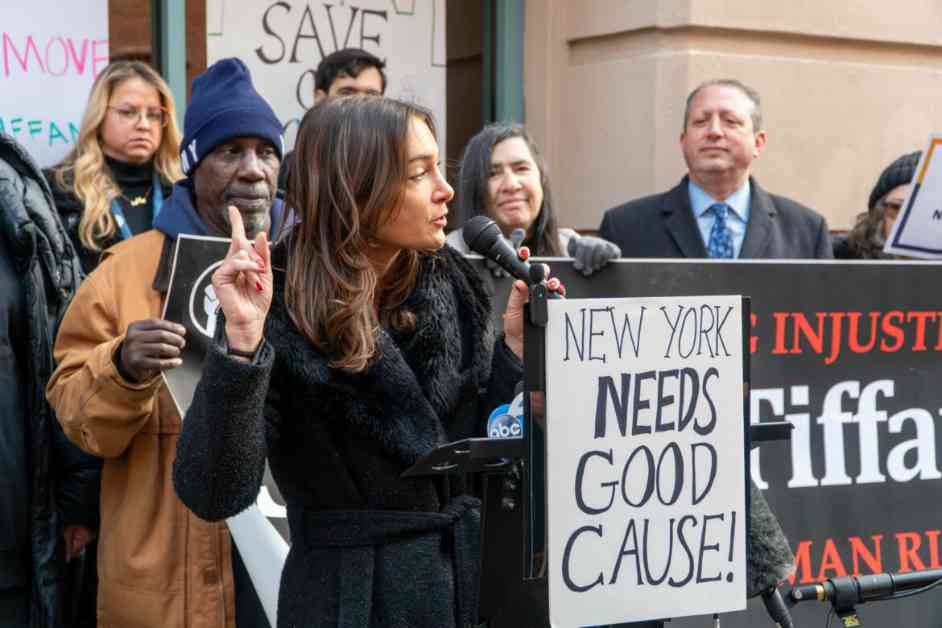State Senator Julia Salazar, a proponent of the Just Cause Eviction initiative, has emphasized that the courts have always been the mechanism for enforcing the law. With the recent addition of a notification requirement for tenants, anticipation is growing for the legal battles that will help define the scope of the new tenant protection law.
The Just Cause Eviction law in New York was enacted over four months ago. The inclusion of protections for Just Cause Eviction was a crucial tool during state budget negotiations, sought after by tenant advocates and progressive lawmakers to replace the 421-a law, which expired in 2022.
However, the version of the law approved in the budget saw a reduction in the scope of its tenant protections and left some of its language vague. As of August 18th, New York landlords are required to notify tenants if the law applies when issuing new or renewed leases, increasing rent, and notifying of eviction or litigation.
Legal experts and advocates for both tenants and landlords have started to weigh in on what to expect and what can be refined with the new law in an already troubled city housing court system.
The law is a defense in housing court that protects tenants against eviction without a legally sufficient reason, such as non-payment of rent, breach of contract terms, or causing disturbances. It can also provide a defense against rent increases above a certain threshold.
Determining whether a residence meets the requirements to be covered by the law can be complicated for tenants. Rent-stabilized apartments and other regulated rental frameworks, such as NYCHA, are not covered under Just Cause Eviction, as they already enjoy many of the same protections.
Small property owner dwellings with 10 or fewer units in New York City are exempt from the law, as are buildings with 10 or fewer units if the owner resides in them. Certain types of housing, such as those provided as part of employment, condos, co-ops, seasonal housing, certain elder and healthcare facilities, prefabricated homes, hotel rooms, dormitories, and religious facilities, are also not covered. Properties built after January 1, 2009, where Just Cause protection will not come into effect until 30 years after construction, are also excluded.
The law also excludes housing rented for more than 245 percent of the Fair Market Rent (FMR) set by the Department of Housing and Urban Development (HUD). In 2024, this means rents above $5,486 for a studio in New York, $6,005 for a one-bedroom, $6,742 for two bedrooms, $8,413 for three bedrooms, and $9,065 for four bedrooms.
While the law is seen as a significant step forward, there are concerns about its imperfect drafting. Legal experts anticipate possible loopholes that landlords may exploit, such as hiding the total number of units they own using a Limited Liability Company (LLC) to avoid being subject to the law.
Another potential issue is landlords claiming demolition plans as an exception to Just Cause Eviction but not following through with them. This raises questions about what constitutes good faith intention and the need for substantial evidence.
Some well-informed tenants have successfully used the law to resolve contractual issues with their landlords, avoiding rent increases and evictions without resorting to legal action. However, if this fails, the only way to legally resolve their issues is to go to court.
AnnLynn Hayashi, a 27-year-old resident raising two daughters in Manhattan, found herself in this situation after her building changed ownership in 2022. The new owner, listed in city property records as EVMF Owner LLC, stopped renewing market-rate leases in the building.
When Hayashi and a neighbor’s leases expired in late May, they were initially relieved that the law could offer them protection against eviction. However, their landlord informed them that they would be using a demolition clause to renovate their apartment. Hayashi believes this demolition plan is false and that the owner is simply converting individual units into dorm-style apartments and raising the rent.
After her lease ended in May, Hayashi continued paying rent to the owner, who accepted it but returned last month’s payment shortly before she received an eviction notice at her door, with a trial date.
Hayashi plans to fight this in housing court and has recently obtained legal representation to prepare a response to the litigation and request the submission of evidence.
As more tenants seek evidence submissions in these cases, concerns arise about potential delays in the process and the financial impact on both tenants and landlords.
Despite these challenges, legal experts and advocates are committed to ensuring that the Just Cause Eviction law is implemented fairly and effectively to protect tenants’ rights. The ongoing legal challenges and court battles will be crucial in shaping the future of tenant protections in New York City.
For State Senator Julia Salazar and other advocates of tenant rights, the fight for stronger tenant protections and affordable housing continues. While the Just Cause Eviction law represents a step in the right direction, there is still work to be done to ensure that all New Yorkers have stable and secure housing.
Whether through improvements to the Just Cause Eviction law or the expansion of rent stabilization measures, the goal remains the same: to provide tenants with the security and stability they need to thrive in their homes.


